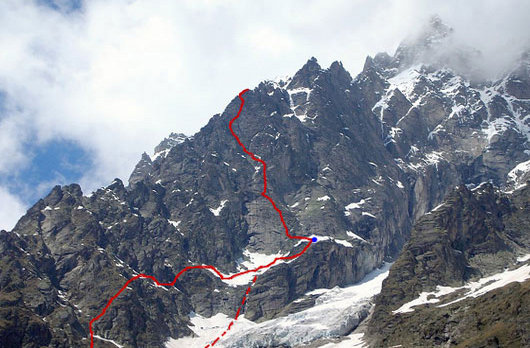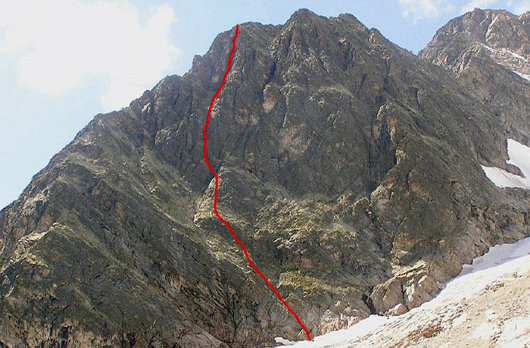
The east face of the Aiguilles de Pra Sec (3549m) on the Italian side of the Mont Blanc range showing the line of La Fiesta de Monstre (TD+, 5.11b, Cytlau-Gillett-Penning-Taylor, 2007). The dashed line shows the original approach across the lower Pra Sec Glacier to the terrace at the start of the routes, while the blue dot marks the British bivouac site. [Photo] Luca Signorelli
British alpinists Gavin Cytlau, Nick Gillett, Tony Penning and Ali Taylor have added a fourth route to the east face of the Aiguilles de Pra Sec (3549m), which form the southern end of the Pra Sec Ridge on the Grandes Jorasses. This remote face above the chaotic Pra Sec Glacier is 600 meters high and was first climbed in 1967 by the British team of Pete Crew, Leo Dickinson and Brian Molyneux at TD- with one pitch of around 5.8/5.9 (although perhaps a name not familiar outside the UK, Crew was one of the foremost, most forceful and competitive British rock climbers of the era, but after relatively short innings gave it up to concentrate on archeology, a field in which he would eventually become well-known and highly respected; Dickinson’s later film making is of course internationally recognized, while Molyneux was also in the forefront of UK new routing in the 1960s). Unaware of the existence of any route on this face, a significant variation was made to this line in 1971, resulting in a second and rather finer climb by the legendary Italians Giancarlo Grassi and Alessandro Nebiolo (TD, 5.7). In 1978 Nebiolo returned and with Bessone, Manera and Pessiva added a third route to the right, a fine climb on sound rock (TD-, 5.8 A1). As far as is known none of these routes has ever been repeated, and the face had to wait nearly thirty years for another ascent.
Main reasons for the neglect are its remote situation, complex approach and rock that can be a little bit “furry” and loose in parts. The previous parties crossed the lower section of the Pra Sec Glacier, but today the icefall at the snout makes this completely inaccessible. Instead, the four British climbers started well to the left and made a monstrously circuitous traverse across ledge systems, taking eight hours to reach the terrace below the start of the climb. This traverse turned out to be almost as hard as the climb itself and probably more scary. They bivouacked on the terrace, climbed the route next day in seven hours and returned to their bivouac site for a second night, before reversing their approach on the third day. The route, which lies left of all the others, is completely independent, and leads to an exit high on the south ridge. The foursome named the new route La Fiesta de Monstre (TD+ but serious for the grade) and found unavoidable difficulties of 5.11b. As is normal with all of Penning’s routes on the Italian side of the Mont Blanc Range, only natural gear was used.
A few days later, Penning and Taylor added another route to the northeast face of Pointe 3019m on the Italian Aiguille de l’Eveque above the Frebouze Glacier. This is another remote granite wall on which there were five previous routes, all climbed by Penning. His new route, Monster Groove (TD, 5.11b obl.), is a prominent series of chimneys left of center on the 500-meter face. The climbing was reported to be sustained, strenuous but good and, although the rock was a bit suspect in parts, it was sound on the difficult sections. No gear was left in place, a rappel descent being made by a previously equipped route. This is the second route on the face for Taylor: in August 2005 she partnered Penning on the Power of Love (5.11a/b, 500m), a line on the left side of the wall finishing up a hidden groove.

The northeast of Pointe 3019m, a subsidiary summit of the Aiguille de l?Eveque above the Frebouze Glacier on the Italian side of the Mont Blanc range. Marked is the line of Monster Groove (TD, 5.11b, Penning-Taylor, 2007). [Photo] Luca Signorelli